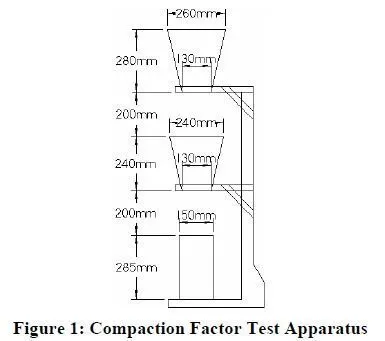The modified slump test (Ferraris and de Larrard 1998; Ferraris 1999; Ferraris and Brower 2001) is intended for use as a field test to measure both the plastic viscosity and yield stress of concrete mixtures. The test adds the parameter of time to the standard slump test in order to measure plastic viscosity.
The apparatus for the modified slump test consists of a vertical rod that extends from a horizontal base plate through the center of the standard slump cone. The slump cone is filled in accordance with ASTM C143 and a sliding disk is placed atop the fresh concrete. Once the slump cone is removed, the time for the disk to slide a distance of 100 mm is measured. The sliding disk comes to rest on a stop located on the vertical rod. After the disk comes to rest, the concrete continues to subside to its final position. The final slump measurement is recorded no later than 60 seconds after the slump cone is removed. A schematic of the test procedure is shown in Figure 5.
The rheological parameters of yield stress and plastic viscosity can be expressed in fundamental units using equations based on the results of the test. The yield stress ( 0 Ï„ , Pa) is expressed in terms of final slump (s, mm) and concrete density ( Ï , kg/m3); while the plastic viscosity (μ , Pa.s) is a function of final slump, slump time (T, sec), and concrete density. The proposed expression for yield stress is the modified form of Equation [1], given previously as Equation [2]
and repeated below:

Nomographs have been developed based on the above equations to allow quick determination of yield stress and plastic viscosity in the field.
Due to the need to measure the time for a slump of 100 mm to be achieved, the test only applies to concrete with slumps ranging from 120 to 260 mm. It has been shown that the rod has a negligible effect on the final slump and that there is no risk of the concrete falling faster than the plate. Other researchers have eliminated the sliding plate and shortened the rod so that it terminates 100 mm below the top of the slump cone (Ferraris 1999). There is a possibility of operator error in determining the precise instances to start and stop the measurement of the slump time.
Additional experimental testing needs to be carried out on a wider range of concrete mixtures in order to verify the validity of the test. Ferraris and Brower (2001) found poor correlation between the results of the modified slump test and plastic viscosity measured with five rotational rheometers.
Advantages:
The test is simple to conduct and only requires slightly more equipment than the slump test.
The test gives an indication of both yield stress and plastic viscosity.
Disadvantages:
The test is not a dynamic test and does not account for the thixotropy of concrete or the ability of concrete to flow under vibration.
Further testing is required to verify the validity of the test.

